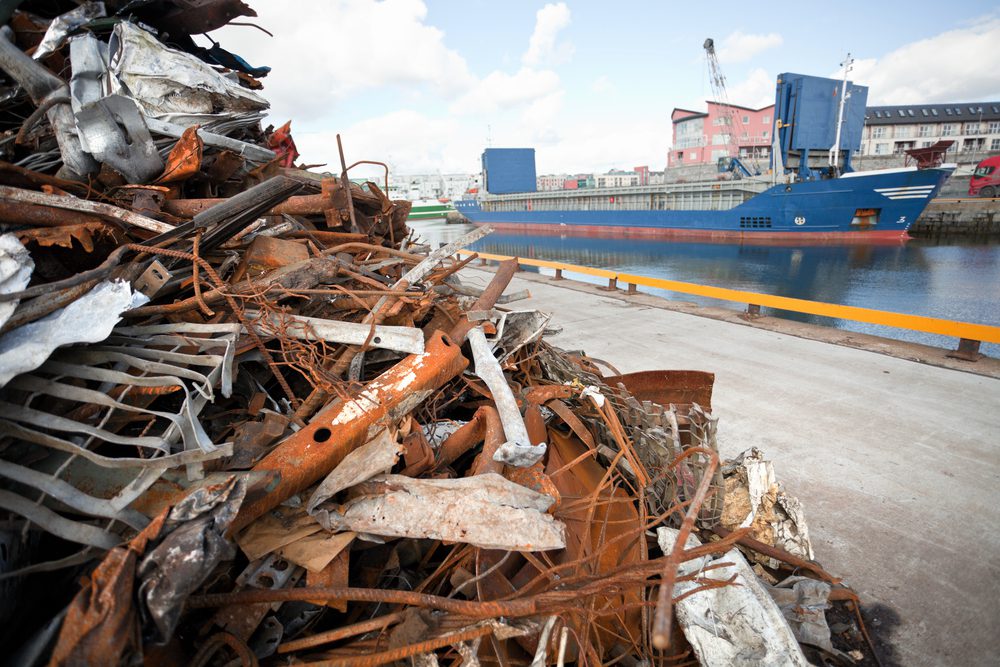Photo: By Rihardzz / Shutterstock
Scrap exports from the United States remained strong in 2017 despite China’s ban on certain scrap imports, which has riled the the global recycling industry since the ban was announced last summer, according to an analysis from the Institute of Scrap Recycling Industries (ISRI) released Thursday.
China notified the World Trade Organization (WTO) in July that it would stop accepting certain scrap shipments, such as waste plastic and paper as part of a campaign against “foreign garbage” by the end of the year. The import ban also covers slag from steelmaking, and many kinds of waste wool, ash, cotton and yarn.
According to the ISRI, however, improved demand for both ferrous (i.e. containing iron) and nonferrous metal scrap more than offset weaker demand for non-metallic scrap, with total U.S. scrap exports advancing in 2017 in both value and volume terms.
“Despite adversity in 2017, the recycling industry proved to be very resilient as it has shown to be so many times in the past,” said ISRI Chief Economist Joe Pickard. “Scrap is a valuable commodity used as feedstock in the manufacturing process in countries around the world. Its constant demand demonstrates the longstanding value and need in the global marketplace. However, while overall exports fared better in 2017 and provide some ground for optimism, one need look no further than the plastics data to see the potential impacts of China’s import ban on other scrap commodities.”
According to recently released Census Bureau data, U.S. exports of all scrap commodities rose to 37.9 million tons valued at $17.9 billion last year, an 8.6% increase in dollar terms. China once again played an important role in U.S. scrap exports. An estimated 31% of U.S. exports, valued at more than $5.6 billion were destined for mainland China in 2017.
“China’s ban and change in regulations will continue to redirect global scrap flows,” Pickard stated. “The implementation of reduced ‘carried waste’ thresholds starting March 1 remains squarely in focus for scrap recyclers despite numerous unanswered questions. Among those questions are: what exactly constitutes carried waste; whether one percent for nonferrous scrap and 0.5% threshold for all other scrap materials can be effectively (and consistently) implemented; and whether import license cuts will be geared mainly toward mixed metal shipments or for all nonferrous scrap commodities. Furthermore, the difference between scrap and waste remains a critical distinction in policy discussions moving forward.”
Nonferrous Scrap
Although U.S. copper and copper alloy scrap exports to mainland China did trail off in the 4th quarter of 2017 (down 10 percent year-on-year), for 2017 as a whole shipments to China increased nearly 4 percent. Overseas demand also improved in Hong Kong, Korea, Japan, Malaysia, Canada, and Mexico last year, helping to boost U.S. copper scrap exports 6.2% in 2017 and above the 1 million ton mark for the first time since 2014 according to the latest Census Bureau trade data.
Unlike the slowdown in 4th quarter copper scrap exports to mainland China, U.S. exports of aluminum scrap to China surged 32 percent higher year-on-year (as compared to the 4th quarter of 2016) to more than 230,000 metric tons during Oct-Dec 2017. As a result, aluminum scrap shipments to China jumped 18.5% higher for 2017 overall, helping to lift total U.S. aluminum scrap exports (including UBC’s and RSI) 15.8% higher to nearly 1.57 million metric tons. Other growth markets for aluminum scrap last year included Korea, Mexico, India, Hong Kong, Indonesia, and Germany according to the Census data.
Ferrous Scrap
U.S. ferrous scrap exports (excluding stainless steel and alloy steel scrap) had their best annual performance since 2014, climbing 23% higher year-on-year by volume to 13.8 million metric tons valued at over $4.1 billion in 2017. Improved demand from Turkey (+16%), Vietnam (+93%), China (+60%), Pakistan (+65%), Bangladesh (+111%), Mexico (+12%), and others contributed to last year’s gains.
Recovered Paper and Fiber
Following China’s notification to the World Trade Organization in July that mixed/unsorted RP imports into the country would be banned, recovered paper export prices (and mixed paper prices in particular) were pressured sharply lower. That reversed significant price gains earlier in the year. As a result, while the total volume of U.S. recovered paper exports dropped from 19.8 million metric tons in 2016 to just over 18.3 million metric tons in 2017, the price strength in the first half of the year carried the dollar value of U.S. recovered paper and fiber exports 1.4% higher to more than $3.2 billion in 2017 thanks in part to stronger sales to India, Mexico, Canada, Indonesia, and Vietnam:
Plastic Scrap
U.S. plastic scrap exports were hit hardest by the Chinese import restrictions announced last year. Plastic scrap export sales to mainland China and Hong Kong dropped 32% and 38%, respectively, in dollar terms in 2017. As Chinese plastic scrap purchases plummeted, the total volume of U.S. plastic scrap exports fell 14 percent to 1.67 million metric tons, the lowest level since 2008. The drop-off in Chinese import demand for plastic scrap was especially dramatic late in the year, despite the regulations not yet coming into effect.
Unlock Exclusive Insights Today!
Join the gCaptain Club for curated content, insider opinions, and vibrant community discussions.

 Join The Club
Join The Club











